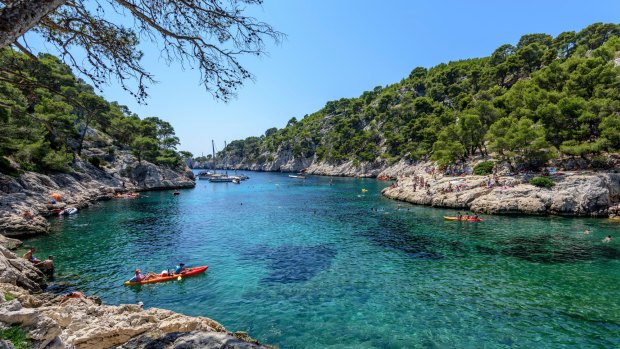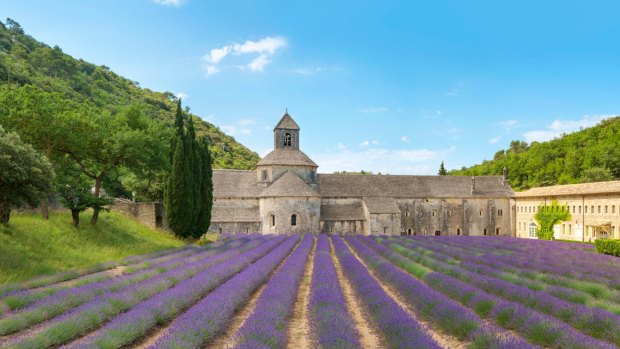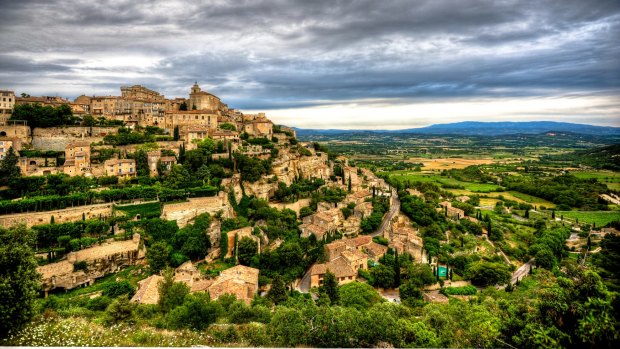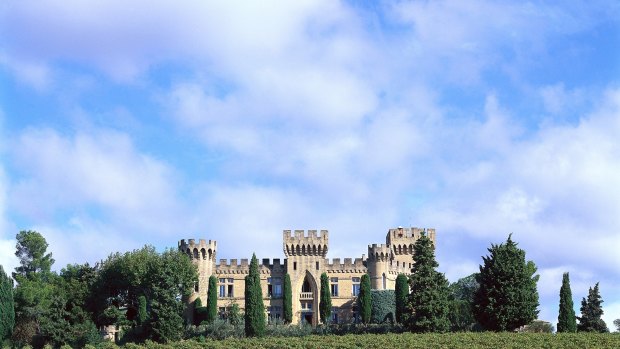By Kristie Kellahan

Kayaking in the calanque of Port-Pin near Cassis, southern France.Credit: David GABIS / Alamy Stock Photo
1. FOLLOW IN PETER MAYLE'S FOOTSTEPS
More than 25 years after his book, A Year in Provence, was first published, Peter Mayle is still receiving fan mail from strangers delighted by his tale of a fifty-something British couple and their two dogs moving to the South of France. In the bestselling book and its sequels, Mayle recounts moving into a 200-year-old stone farmhouse in the Luberon to experience rural village life, a la Francais. Tours of the region, "in the footsteps of Mayle", are available.

Lavender fields in full bloom in early July in front of Abbaye de Senanque Abbey, Vaucluse, Provence-Alpes-Cote d'Azur, France.Credit: Jason Langley/Getty
2. SWIM IN THE CALANQUES AT CASSIS
Pack your swimsuit and walking shoes to discover the wilderness on the doorstep of Cassis. The stretch of coast between the pretty little fishing village and Marseille boasts soaring sea cliffs and rocky inlets, known as calanques. The sparkling blue Med beckons swimmers to make the trek down to the water's edge. Port-Miou, to the east, is the easiest to reach, just 20 minutes from the Cassis promenade. The water here is as inviting as any you'll find at the packed Cote d'Azur beaches (St Tropez, Cannes, Cap Ferrat).
See ot-cassis.com/en

The striking hilltop town of Gordes in Provence, France. Credit: See me on Flickr account-metal543
3. SHOP THE MARKETS
Shopping the Provencal markets for fresh produce and flowers is an essential experience, and also one of the best ways to mingle with the locals. Almost every village has a weekly market; some occur several times a week or daily. In the big towns like Apt and Aix-en-Provence, the markets continue along many streets and squares, joining together sections dedicated to produce, flowers, antiques and clothes. In smaller towns, you might find a dozen or so stalls, set up to sell local fish, bread, pastries, fruit, olive oils and wine. In addition to sun-ripened apricots and shiny olives, be on the lookout for non-food staples of the region: Savon de Marseille, said by many to be the best soap in the world; colourful textiles; and original artworks.

Vineyards and chateaux in Chateauneuf-du-Pape, Provence. Credit: Juergen Richter / LOOK-foto/Getty
4. EAT BOUILLABAISSE
In France's oldest city, Marseille, restaurant menus list an abundance of fresh seafood prepared in simple and delicious ways. Eat your way around the old port, where dozens of spruikers entice diners with the same promise: the very best bouillabaisse in town. The famous fish stew originated here in Marseille and today is found everywhere. Take a morning wander along the waterfront to see the fishing boats coming back in with the catch of the day. Fresh seafood can be purchased on the spot.
5. STROLL AIX'S BOULEVARD
Described as a mini Paris, Aix-en-Provence is one of the most gorgeous cities in France. The Cours Mirabeau, a wide tree-lined promenade first opened almost 400 years ago to give wealthy residents a pleasant place to stroll, is still the go to spot for people-watching. Flanked by cafes on one side, 17th and 18th century townhouses on the other, the boulevard is dotted with fountains and statues. Market stalls selling local handicrafts, soaps, nougat and wine are set up in front of the townhouses.
See aixenprovencetourism.com/en
6. BRUSH UP ON YOUR ANCIENT ROMAN HISTORY
Many moons ago, the Romans declared the region the first Roman province beyond the Alps. Named at the time Provincia Romana, it was ruled from Aix-en-Provence until 1481, when the Kings of France took control. More than 500 years later, Provence is a living museum of some of the best-preserved Roman ruins in Europe. History-hunters should head to Nimes to see its remarkable amphitheatre, a Corinthian temple that has stood for more than 2000 years, and many more monuments. The UNESCO-recognised Pont du Gard aqueduct, spanning the Gardon River, is still a marvel of engineering. And in Orange, the Theatre Antique, vast enough for 10,000 spectators, is one of the most interesting Roman ruins in Provence.
See pontdugard.fr/en, theatre-antique.com
7. FOLLOW THE ARTISTS' TRAIL
The colours and light of Provence and the Cote d'Azur have been seducing artists and writers since Adam was a boy. On the French Riviera, museums honour the vision of Picasso, Matisse and Chagall, to name a few. In Aix-en-Provence, Cezanne's life and work is celebrated at his former studio, where many of his personal belongings are preserved.
Vincent Van Gogh lived in Arles for more than a year, a prolific period in which he produced more than 300 works, including Starry Night Over the Rhone. The visitor's centre in Arles provides a walking tour map of the places he painted. At the Fondation Van Gogh, some of his best-loved works are on display.
See fondation-vincentvangogh-arles.org, atelier-cezanne.com, museumspass.com/en
8. CATCH A FESTIVAL
Summer is festival season in Provence, though in truth there is always some celebration to join in. Highlights of the warmer months: Avignon's theatre festival, Festival d'Avignon, often compared with the Edinburgh Festival; Orange's celebration of opera, Choregies d'Orange; and a citywide international photography exhibition in Arles, the Rencontres. Chateauneuf du Pape, a standout wine region, becomes a medieval village for one weekend in early August. Countless village festivals and street parades are celebrated in the smaller towns.
See seeprovence.com
9. DRINK THE LOCAL DROP
Provence is pretty in pink – rosé pink, that is. Rosé wine is more than half of all wine produced in Provence and a perennial crowd pleaser at bars and restaurants throughout France. Some red wine varieties are also produced in Provence, full-flavoured Mourvedres and Grenaches. The area around Cassis is known for turning out good white wine, namely Clairette, Marsanne and Sauvignon Blanc.
If you find yourself quaffing in a Marseille bar, make it a pastis. The anise-flavoured spirit is normally diluted with water, served cold. Petanque game, optional.
10. STAY IN AVIGNON
Don't miss the Palais des Papes (the Pope's Palace) and the impressive cathedral in Avignon. The 14th century residence of seven successive popes, Avignon is steeped in medieval history and religious ritual. Many hotels here are housed in 16th-19th century stone buildings, with heritage facades and the character (but hopefully not the plumbing) of another era. Consider Hotel de l'Horloge, Hotel d'Europe and La Ferme.
See hotel-avignon-horloge.com/en, heurope.com and hotel-laferme.com
11. PHOTOGRAPH THE PINK SALT MARSHES
The Aigues-Mortes salt marsh spans an area roughly the equivalent size of central Paris. With 7000 hectares turned over to the production of sea salt, this natural phenomenon dates back to Roman times, when "white gold" was highly coveted, the only way to preserve food. Some of the salt flats produce pink salt, the intense colour turning the watery marshes a Diana Vreeland-worthy shocking fuchsia that photographs brilliantly against a cloudless blue sky.
See visitesalinsdecamargue.com
12. CRUISE THE RIVERS AND CANALS
With the seemingly unstoppable rise in popularity of cruise holidays, operators are on the lookout for new waterways to explore. Provence's Rhone river, Petit Rhone, Canal du Midi and Canal Rhone a Sete are on their radar. In 2016, Back-Roads Touring began chartering CroisiEurope barge vessels to accommodate travellers on escorted cruise/drive tours of Provence. Self-chartered canal cruising is another option for independent travellers and small groups.
See backroadstouring.com, canalcruisinginfrance.com
13. SEE WHAT ARLES THE FUSS IS ABOUT
Two thousand years of Roman history was enough for Arles to be classified as a UNESCO World Heritage site. An intact amphitheatre is still used today for concerts, bull fights, and even yoga classes. Roman theatres, cathedrals and sculptures are a protected part of daily life for the 50,000 residents and many more visitors who have also put Arles on the tourist map for its place in art history (see point 7) and modern photography culture (see point 8).
14. EXPLORE THE CAMARGUE
The marshy wetlands of the Camargue, where the Rhone meets the sea, are home to a vast ecosystem bursting with life and colour. Flamboyances of pink flamingoes (surely one of the most apt collective nouns we've ever heard), white Camargue horses and black bulls are some of the symbols of this delta region. Grittier and more rural than the quaint, pretty Provence villages, the Camargue will show a different side of France to visitors. Bike, hike or see the region on horseback or from a horse-drawn carriage. Take off in a helicopter for an unforgettable perspective.
15. MEET A FRENCH COWBOY
In France's Wild West, the Camargue, it's possible to meet cowboys and tour ranches (manades) where they raise horses and bulls. A long tradition of bullfighting in the rings and amphitheatres of the bull-crazy region means big business for the ranchers: the best running bulls can earn more than €5000 for 15 minutes in the rodeo ring. Unlike Spanish style bull-fighting, the aim of the French version is to successfully grab ribbons and strings from the animal's horns, then run like hell. Around 150 manades in the Camargue are devoted to bull-rearing; many offer tours.
16. LEARN ABOUT LAVENDER
It has been said that lavender is the soul of Provence, and everywhere from Luberon to Aix to Roussillon you'll find gorgeous fields of the purple plant blooming in the summertime. Valensole Plateau is lavender central, swarming with photographers in July each year.
Used for centuries as a cure-all, the "blue gold" is harvested and sent to distilleries to be used in aromatherapy oils, lotions, soaps and tinctures. Visit Les Agnels distillery for a guided tour of the processing plant and fields, or time your visit to coincide with summertime Lavender Festivals in Sault and Valreas. The museum in Coustellet is also worth a look.
See lesagnels.com and museedelalavande.com
17. TASTE THE LOCAL FLAVOURS
Lavender lovers will be in tastebud heaven in Provence: quelle surprise, the aromatic plant is used to flavour everything from ice cream to creme brulee to infused teas and honey.
Dishes served "a la Provençale", meaning they are prepared in the style of Provence, typically feature garlic, olive oil and olives. A Mediterranean influence is not hard to spot: many sauces are tomato-based, chunky with vegetables and seasoned with zesty "herbes de Provence". Ratatouille is popular.
Naturally you'll find an abundance of all kinds of cheese – this is France, after all – though goat cheese, or chevre, is mainly produced here.
18. VISIT THE SMALL VILLAGES
Sure, the blockbuster A-list towns – Arles, Avignon, Aix-en-Provence – live up to their hype. But to get a taste of traditional Provence life at a slower pace, be sure to visit at least one or two of the smaller villages. In the narrow streets in the centres of Pezenas and Uzes, it takes no great stretch of imagination to picture how locals lived during medieval times. Gordes and Roussillon, beautiful towns built on hilltops not far from Avignon, delight visitors with panoramic views.
See tourismepaca.fr
19. RENT A PRIVATE VILLA
Gather a dozen friends or family members to split the cost of renting a private villa in Provence and it becomes a lot more affordable. Popular for milestone birthday celebrations, destination weddings and hang-the-expense retirement trips, Provence villa rentals are in highest demand from May to September. Some of the options include homesteads on olive farms, restored medieval cottages surrounded by lavender fields and sleek, modern hilltop homes with infinity pools. See myprivatevillas.com
20. GET TO KNOW THE GORGES
Adventure seekers, take note. Verdon Gorges, Europe's equivalent of the Grand Canyon, is epic. Almost 25 kilometres long, with a drop of more than 600 metres from top to bottom, the Verdon is a favourite of hikers from around the world. Pitch a tent at one of the designated campsites, bike along beautiful trails to scenic lookouts, or take to the water in a canoe to discover prehistoric sites where it is believed cavemen once lived.
Kristie Kellahan travelled as a guest of Back-Roads Touring.
Sign up for the Traveller Deals newsletter
Get exclusive travel deals delivered straight to your inbox. Sign up now.